Civil Rights Act of 1964 Facts & Worksheets
Civil Rights Act of 1964 facts and information activity worksheet pack and fact file. Includes 5 activities aimed at students 11-14 years old (KS3) & 5 activities aimed at students 14-16 year old (GCSE). Great for home study or to use within the classroom environment.
School History > Modern World > Civil Rights Act of 1964 Facts & Worksheets
Download Civil Rights Act of 1964 Worksheets
Do you want to save dozens of hours in time? Get your evenings and weekends back? Be able to teach Civil Rights Act of 1964 to your students?
Our worksheet bundle includes a fact file and printable worksheets and student activities. Perfect for both the classroom and homeschooling!
Resource Examples
Click any of the example images below to view a larger version.
Fact File
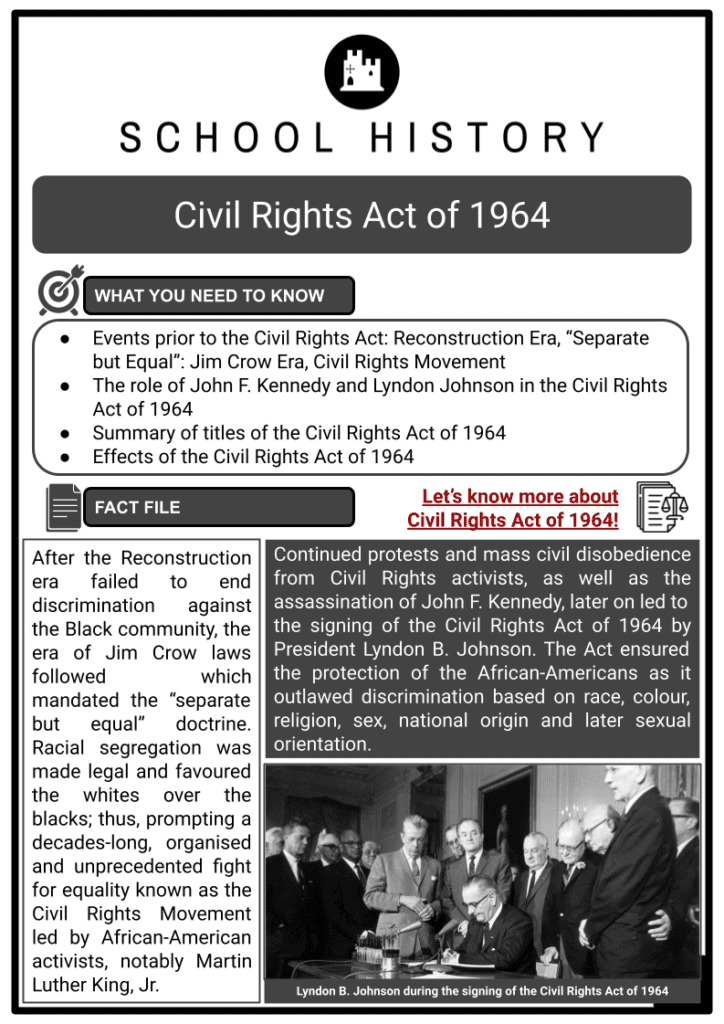
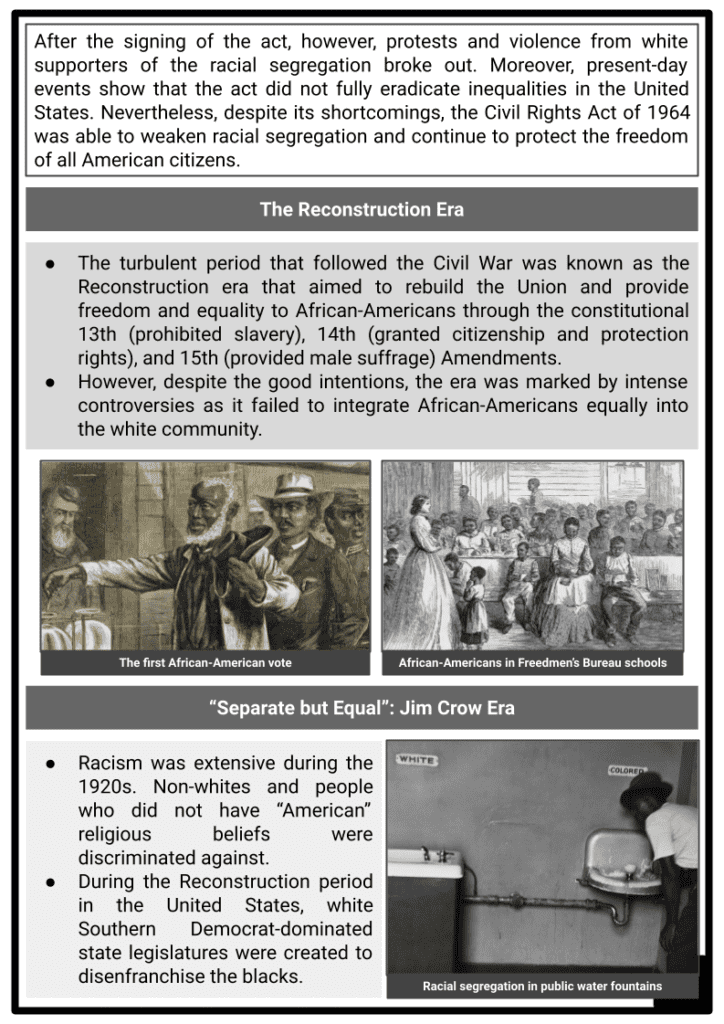
Student Activities
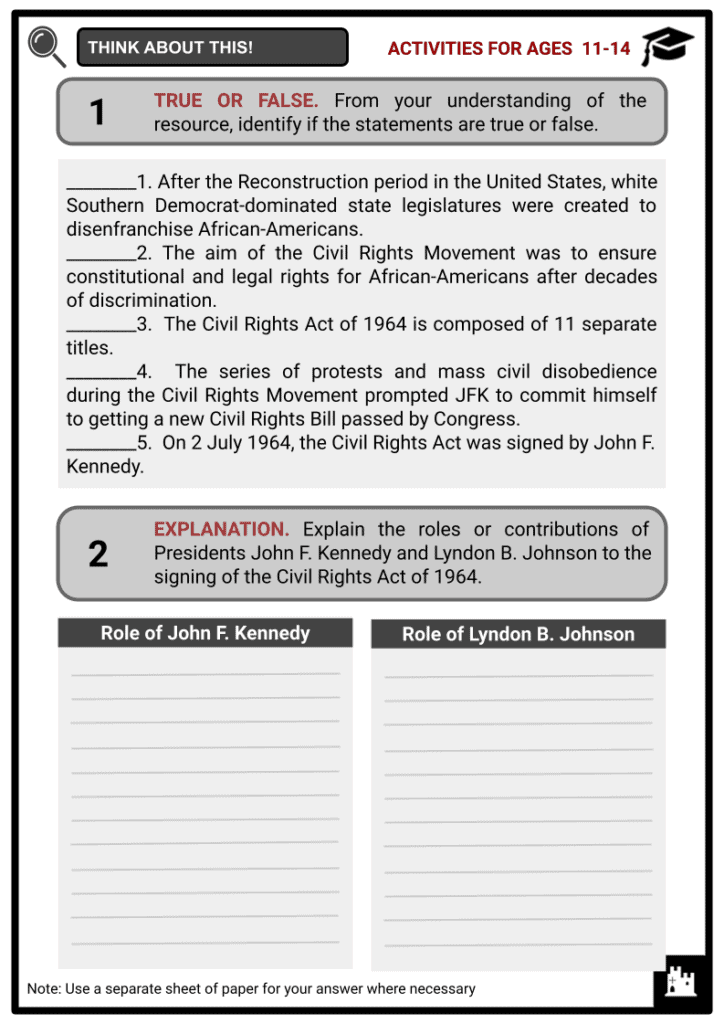
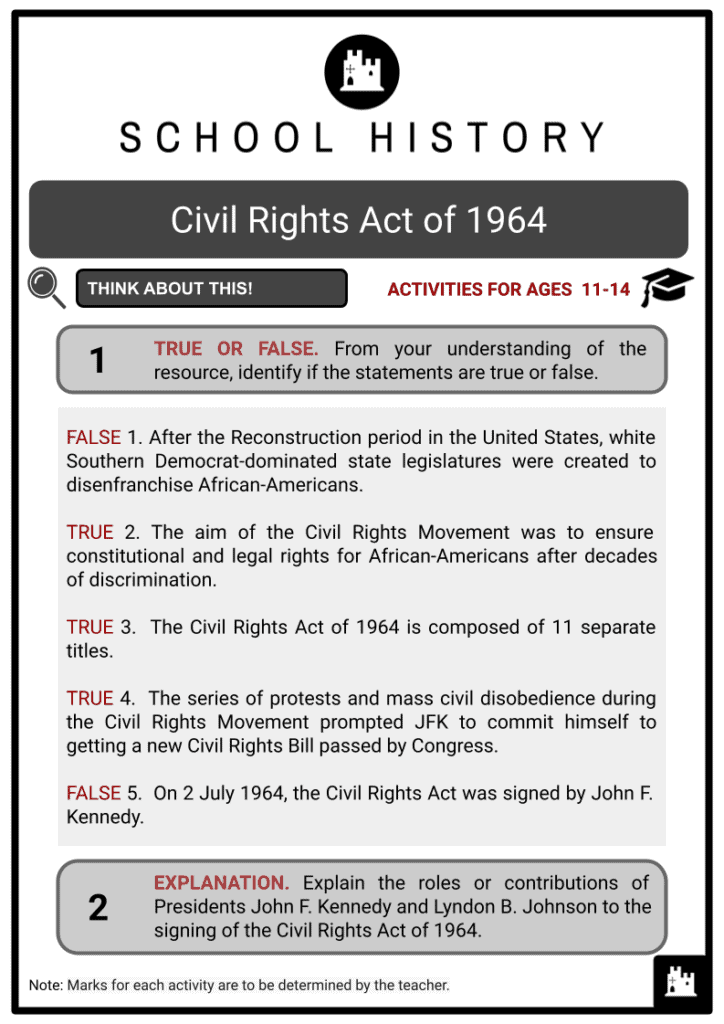
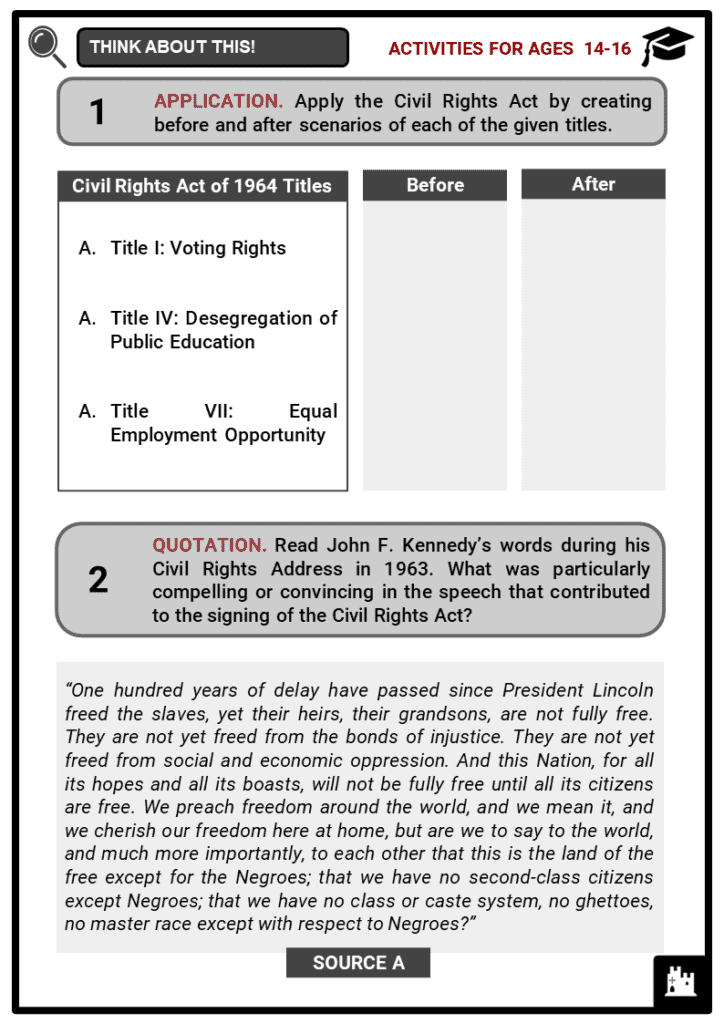
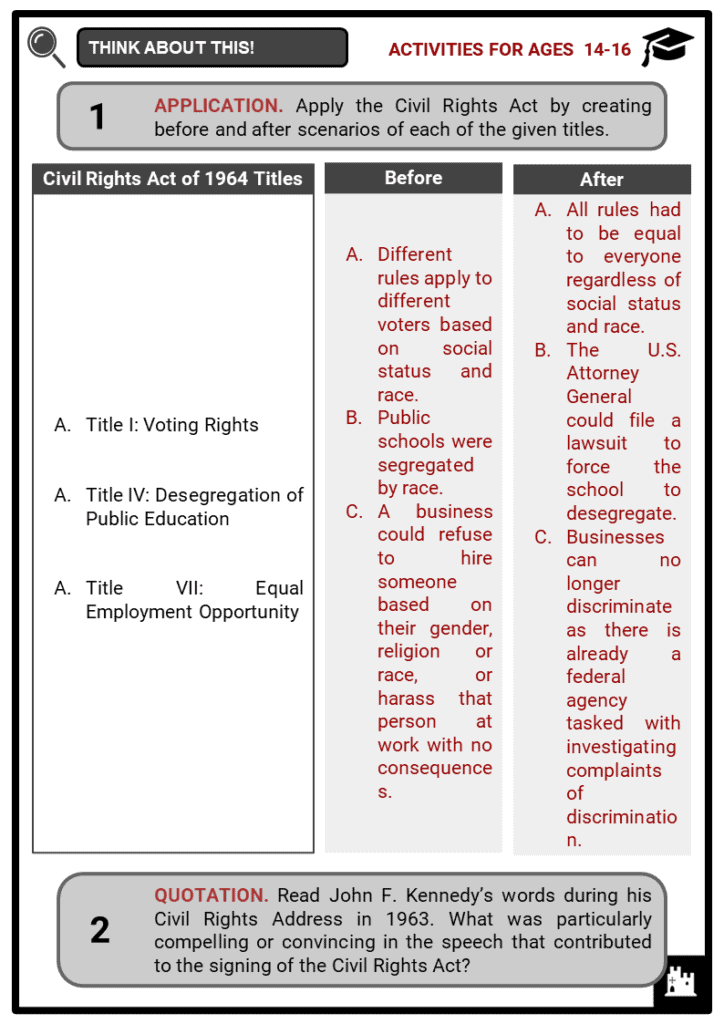
Table of Contents
Add a header to begin generating the table of contents
Summary
- Events prior to the Civil Rights Act: Reconstruction Era, “Separate but Equal”: Jim Crow Era, Civil Rights Movement
- The role of John F. Kennedy and Lyndon Johnson in the Civil Rights Act of 1964
- Summary of titles of the Civil Rights Act of 1964
- Effects of the Civil Rights Act of 1964
Key Facts And Information
Let’s know more about Civil Rights Act of 1964!
- After the Reconstruction era failed to end discrimination against the Black community, the era of Jim Crow laws followed which mandated the “separate but equal” doctrine. Racial segregation was made legal and favoured the whites over the Blacks; thus, prompting a decades-long, organised and unprecedented fight for equality known as the Civil Rights Movement led by African-American activists, notably Martin Luther King, Jr.
- Continued protests and mass civil disobedience from Civil Rights activists, as well as the assassination of John F. Kennedy, later on led to the signing of the Civil Rights Act of 1964 by President Lyndon B. Johnson. The Act ensured the protection of African-Americans as it outlawed discrimination based on race, colour, religion, sex, national origin and later sexual orientation.
- After the signing of the act, however, protests and violence from white supporters of racial segregation broke out. Moreover, present-day events show that the act did not fully eradicate inequalities in the United States. Nevertheless, despite its shortcomings, the Civil Rights Act of 1964 was able to weaken racial segregation and continue to protect the freedom of all American citizens.
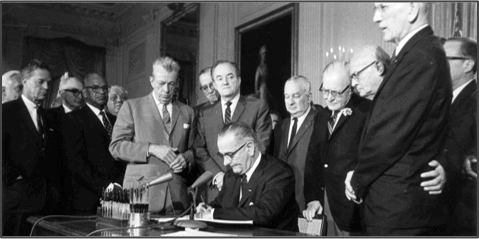
The Reconstruction Era
- The turbulent period that followed the Civil War was known as the Reconstruction era that aimed to rebuild the Union and provide freedom and equality to African-Americans through the constitutional 13th (prohibited slavery), 14th (granted citizenship and protection rights), and 15th (provided male suffrage) Amendments.
- However, despite the good intentions, the era was marked by intense controversies as it failed to integrate African-Americans equally into the white community.
“Separate but Equal”: Jim Crow Era
- Racism was extensive during the 1920s. Non-whites and people who did not have “American” religious beliefs were discriminated against.
- During the Reconstruction period in the United States, white Southern Democrat-dominated state legislatures were created to disenfranchise African-Americans.
- The Jim Crow laws refers to the series of laws that legalised racial segregation from the end of the Reconstruction period in the late 19th century until the enactment of the Voting Rights Act in the early 20th century.
- This series of laws was known for its legal doctrine “separate but equal” that was applied to the facilities made for African-Americans.
- The “separate but equal” legal doctrine was first upheld during the Plessy v. Ferguson case in 1895 that found state laws requiring racial segregation to be constitutional.
- Racial segregation through the Jim Crow system was a way of life. After its establishment, numerous states enforced legal punishments when consorting with another race.
- It cemented racial discrimination and favoured white people over Black people.
- White supremacy became observable in terms of unequal work opportunities and in government, schools, churches and hospitals, to name just a few.
Civil Rights Movement
- By the middle of the 20th century, African-Americans became tired of succumbing to racist whites and thus, resulting in a decades-long organised and unprecedented fight for equality known as the Civil Rights Movement.

- The aim of the Civil Rights Movement was to ensure constitutional and legal rights for African-Americans after decades of discrimination.
- The Civil Rights Movement reached its peak in the 1960s, when protests and mass civil disobedience campaigns were organised.
- Notable protests and Supreme Court rulings that prompted the Civil Rights Act were: Brown v. Board of Education, Emmett Till’s murder, Montgomery Bus Boycott, Little Rock Nine, Sit-in Movement, and Martin Luther King’s March on Washington for Jobs and Freedom.
- John F. Kennedy was the 35th president of the United States.
- At the age of 43, he became the youngest and first Roman Catholic elected president of America.
- As an admirer of Martin Luther King Jr., he was convinced by his arguments and supported the sentiments of African-Americans.
- He was vocal in his opinions of racial discrimination in the US.
- Hence, he set up committees to work out how to improve education, housing and work opportunities for African-Americans.
- The demonstrations and protests that King led played an important role in getting Congress to pass the Civil Rights Act in July 1964, which ended segregation in the South.
- John F. Kennedy, at first, was opposed to the March on Washington for Jobs and Freedom in 1963, thinking it could be used as an excuse by Congress to reject his Civil Rights Bill. Later on, he supported it as a good example of racial harmony and African-American moderation.
- The series of protests and mass civil disobedience during the Civil Rights Movement led to a wave of civil rights action across the US that prompted JFK to commit himself to getting a new Civil Rights Bill passed by Congress.
- In a nationally televised address, JFK proposed the Civil Rights Act.
- Unfortunately, JFK was not able to sign his proposed Civil Rights Act because he was filibustered in the Senate.
- Moreover, on 22 November 1963, he was assassinated by Lee Harvey Oswald while riding a presidential motorcade through Dealey Plaza in Dallas, Texas.
- On 22 November 1963, Vice-President Lyndon B. Johnson was sworn in as president of the United States after the assassination of John F. Kennedy in Dallas, Texas.
- While many Americans were grieving the death of JFK, Johnson took the opportunity to push through some of Kennedy’s agenda, including tax cuts and the Civil Rights Act.
- He had been a supporter of civil rights since the mid-1950s, being one of only a few Southern politicians who supported the Supreme Court’s ruling in the Brown case of 1954, which ruled segregated schools unconstitutional.
- Johnson thought racism was ‘un-American’ and damaged the country’s image abroad.
- He also wanted to pay tribute to JFK after his assassination by getting the Civil Rights Bill signed into law.
- In June 1963, Johnson proposed a comprehensive civil rights legislation adding that the United States “will not be fully free until all of its citizens are free.”
- Finally on 2 July 1964, after the Senate favoured it with 73-27, the Civil Rights Act was signed in front of television cameras.
- The signing of the Civil Rights Act of 1964 on national television can be watched here: https://www.youtube.com/watch?v=sQjNESlx5Zc.
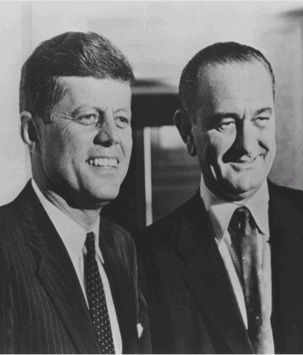
The Civil Rights Act of 1964
- "An act to enforce the constitutional right to vote, to confer jurisdiction upon the district courts of the United States to provide injunctive relief against discrimination in public accommodations, to authorize the Attorney General to institute suits to protect constitutional rights in public facilities and public education, to extend the Commission on Civil Rights, to prevent discrimination in federally assisted programs, to establish a Commission on Equal Employment Opportunity, and for other purposes."
- The Civil Rights Act of 1964, notable for being the most comprehensive civil rights legislation to date, is composed of 11 separate titles.
- TITLE I: Voting Rights
- This title prohibited the unequal application of voter registration requirements. However, though it required voting rules and procedures to be equal for all races, it did not remove the literacy tests, abolish voter “qualification”, and address the physical violence, economic retaliation and police repression that prevented the blacks from voting.
- The Voting Rights Act which would come the year after was the one that directly addressed the voting qualifications.
- In this title, discrimination based on colour, race, religion, or national origin in public accommodations like hotels, restaurants and theatres was outlawed. This, however, exempted private clubs.
- Resistance to the public accommodation clause of the Civil Rights Act of 1964 continued even after its passing. One notable historical event that involved it was the “Orangeburg massacre” that violently attacked local college students when they attempted to desegregate a bowling alley in Orangeburg, South Carolina in 1968.
- This title prohibited the state and local governments from denying access to public facilities or public properties based on colour, race, religion, or national origin.
- The basis for the desegregation of public schools can be seen in this title. It authorised the Office of Education (now called the Department of Education) to assist with the desegregation.
- The earlier Civil Rights Act of 1957 established the Civil Rights Commission. This title expanded the said commission with additional powers, rules and procedures.
- This title forbade discrimination by federally assisted programmes based on colour, race, religion, or national origin. If one violates this, the recipient may lose federal funding.
- This title prohibited discrimination by covered employers on the basis of colour, race, or national origin through the creation of an Equal Employment Opportunity Commission.
- In 1972, Title VII of the Civil Rights Act of 1964 was amended through the Equal Opportunity Act.
- The employer mentioned is only applied to one "who has fifteen (15) or more employees for each working day in each of twenty or more calendar weeks in the current or preceding calendar year”. The title also prohibited discrimination against an individual’s association to another individual of a particular race, colour, religion, sex, or national origin, with the inclusion of interracial marriage.
- In this title, compilation of voting data as well as voter registration in specific areas specified by the Commission on Civil Rights were required.
- This title specifically made it easier for civil rights cases to move from state courts to federal court. This benefitted civil rights activists who sought to get fair trials in state courts.
- This title established the Community Relations Service that would assist conflicts that involved discrimination claims.
- This title afforded defendants accused of criminal contempt under the act the right to a trial by jury.
Effects of the Civil Rights Act
- After the passing of the bill, protests and violence from white supporters of racial segregation broke out. President Johnson also mused that the Civil Rights Act was an important gain but he thought that “we just delivered the South to the Republican Party for a long time to come”. Considering the present day, the Civil Rights Act of 1964 proved that it was not able to fully reconcile inequality in the United States.
- Statistical data showed that white families have three times more wealth on average than African-American families because of continuing inequalities from laws and practices that prevented African-Americans from making money and owning property.
- Furthermore, these inequalities continued to show in the recent killing of African-American George Floyd in May 2020.
- In May of 2020, George Floyd was killed in Minneapolis during an arrest by a white police officer named Derek Chauvin after a shop assistant alleged he gave a counterfeit $20 bill. Witnesses responded that Chauvin knelt down on Floyd’s neck for a whole 8 minutes, resulting in his death.
- Nevertheless, the law led to further legislation that protected civil rights for all Americans like the Voting Rights Act of 1965 that further strengthened protections against discriminatory voting; and the Fair Housing Act of 1968 that made discrimination illegal in selling, buying, or renting property.
- Also, Title VII of the act that mentioned equal employment for all Americans regardless not only of colour and race but also sex, delivered a historic ruling on 15 June 2020 on protecting the LGBTQ against workplace discrimination.
- The Civil Rights Act of 1964 remains one of the Civil Rights Movement’s greatest achievements.
- Despite its shortcomings, the Civil Rights Act of 1964 was able to weaken racial segregation and continue to protect the freedom of American citizens regardless of colour, race, sex, or national origin.
Image sources:
- https://mediadc.brightspotcdn.com/dims4/default/191c802/2147483647/strip/true/crop/3000x2051+0+0/resize/3000x2051!/quality/90/?url=https%3A%2F%2Fmediadc.brightspotcdn.com%2F2c%2F03%2F95bf5ebdc5f17dea34db5996d95b%2F9cf8e3330e246825fc4c567143f44320.jpg
- https://www.thenation.com/wp-content/uploads/2016/07/MLK_march_on_washington_ap_img-1440x756.jpg
- http://www.covenersleague.com/images/JFK-and-Lyndon-Johnson.jpg










